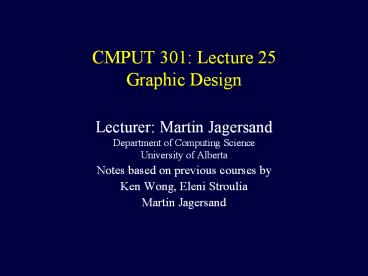CMPUT 301: Lecture 25 Graphic Design - PowerPoint PPT Presentation
Title:
CMPUT 301: Lecture 25 Graphic Design
Description:
Graphic Design. Lecturer: Martin Jagersand. Department ... Graphic Design. What: ... design individual characters, symbols, and graphic elements to be easily ... – PowerPoint PPT presentation
Number of Views:236
Avg rating:3.0/5.0
Title: CMPUT 301: Lecture 25 Graphic Design
1
CMPUT 301 Lecture 25Graphic Design
- Lecturer Martin Jagersand
- Department of Computing Science
- University of Alberta
- Notes based on previous courses by
- Ken Wong, Eleni Stroulia
- Martin Jagersand
2
Graphic Design
- What
- the use of typography, symbols, color, and other
static and dynamic graphics to convey facts,
concepts, and emotions
3
Graphic Design
- Why
- can be used in user interface design to convey
information effectively about system
functionality and state
4
Graphic Design
- Visible language
- layout
- formats, proportions, alignment
- typography
- typefaces, typesetting
- color
- colors, texture
- imagery
- signs, symbols, icons
- sequencing
- animation, order of operations
5
Graphic Design
- Basic principles of design
- organize
- provide a clear and consistent conceptual
structure - economize
- maximize the effectiveness of a minimal set of
cues - communicate
- match the presentation to the capabilities of the
user
6
Graphic Design
- Apply these principles to design menus, control
panels, dialog boxes, icons, etc.
7
Organize
- Internal consistency
- observe the same conventions and rules for all
elements of the user interface
8
(No Transcript)
9
(No Transcript)
10
(No Transcript)
11
(No Transcript)
12
Organize
- External consistency
- follow existing platform and cultural conventions
across user interfaces
13
(No Transcript)
14
Organize
- World consistency
- make conventions consistent with real-world
experience
15
(No Transcript)
16
(No Transcript)
17
(No Transcript)
18
(No Transcript)
19
(No Transcript)
20
Organize
- Lexical consistency
- coding consistent with common usage
- e.g., left less, right more
- consistent abbreviation rules
- e.g., Jan, Feb, Mar, etc. (equal length)
- devices used consistently
- e.g., esc key to cancel
- symbols used consistently
- e.g., ellipsis () to bring up a dialog box from
a menu item or button
21
Organize
- Syntactic consistency
- status messages consistently placed
- e.g., for Internet Explorer, at bottom of window
- commands come first or last
- e.g., verb then noun (command line)
- e.g., noun then verb (direct manipulation)
- menu items always at the same place
- i.e., perceived stability muscle memory
22
(No Transcript)
23
Organize
- Semantic consistency
- global commands always available
- e.g., help, cancel, undo
- e.g., cut/copy/paste
24
CMPUT 301 Lecture 25b Graphic Design
- Lecturer Martin Jagersand
- Department of Computing Science
- University of Alberta
- Notes based on previous courses by
- Ken Wong, Eleni Stroulia
- Martin Jagersand
25
Graphic Design
- Basic principles of design
- organize
- provide a clear and consistent conceptual
structure - economize
- maximize the effectiveness of a minimal set of
cues - communicate
- match the presentation to the capabilities of the
user
26
Tools in graphic design
- Visible language
- layout
- formats, proportions, alignment
- typography
- typefaces, typesetting
- color
- colors, texture
- imagery
- signs, symbols, icons
- sequencing
- animation, order of operations
27
Organize
- Screen layout
- use grids and alignment
- group related elements
- use balance and symmetry
- use task analysis for ordering
- standardize placements
- e.g., cancel button to left of OK button
- address perceived stability
28
(No Transcript)
29
Organize
- Grouping methods
- proximity
- alignment
- separators
- borders
- background color
- indentation
30
(No Transcript)
31
(No Transcript)
32
Organize
- Navigability
- provide an initial focus for attention
- direct attention to important, secondary, or
peripheral items - assist navigation among the elements
33
Example Navigability
34
Economize
- Simplicity
- KISS principle
- i.e., keep it simple, stupid
- minimize the use of colors and styles
- avoid the circus effect
- minimize clutter
- but do not hide essential information
- e.g., reveal details, use tabs
35
Example KISS
36
Economize
- Clarity
- design all elements so that their meaning is not
ambiguous - use affordances
- use plain language
37
Economize
- Distinctiveness
- distinguish important properties of essential
elements and make the most important elements
obvious
38
(No Transcript)
39
Communicate
- Legibility
- design individual characters, symbols, and
graphic elements to be easily noticeable and
distinguishable - Readability
- design detailed displays to be comprehensible,
inviting, and attractive
40
Communicate
- Typography
- limit the number of typefaces
- e.g., max 3 legible/readable typefaces
- limit the length of lines
- i.e., max 40 to 60 characters
- use appropriate justification
- e.g., right justified for columns of numbers
- avoid all caps for body text
41
Example Typography for edit boxes
- Proportional spacing
- Hard to see errors when typing in
- Fixed spacing, bold
- Easy to see individual characters
42
Communicate
- Imagery
- signs, symbols, icons
- icon design is difficult
- use standards if possible
- label unfamiliar icons
- avoid gratuitous images
- e.g., animated icons
43
(No Transcript)
44
Communicate
- Color and texture
- use appropriate highlighting and deemphasis
techniques to convey meaningful semantic
distinctions
45
(No Transcript)
46
Communicate
- Aspects of visual design
- scale
- size of a specific element relative to other
elements and the whole composition - contrast
- noticeable differences along a common visual
dimension - proportion
- balance and harmony of the relation between
elements
47
Specific design examples
- Look at Joel's writings on UI
- http//static.userland.com/gems/joel/uibookcomplet
e.htm































